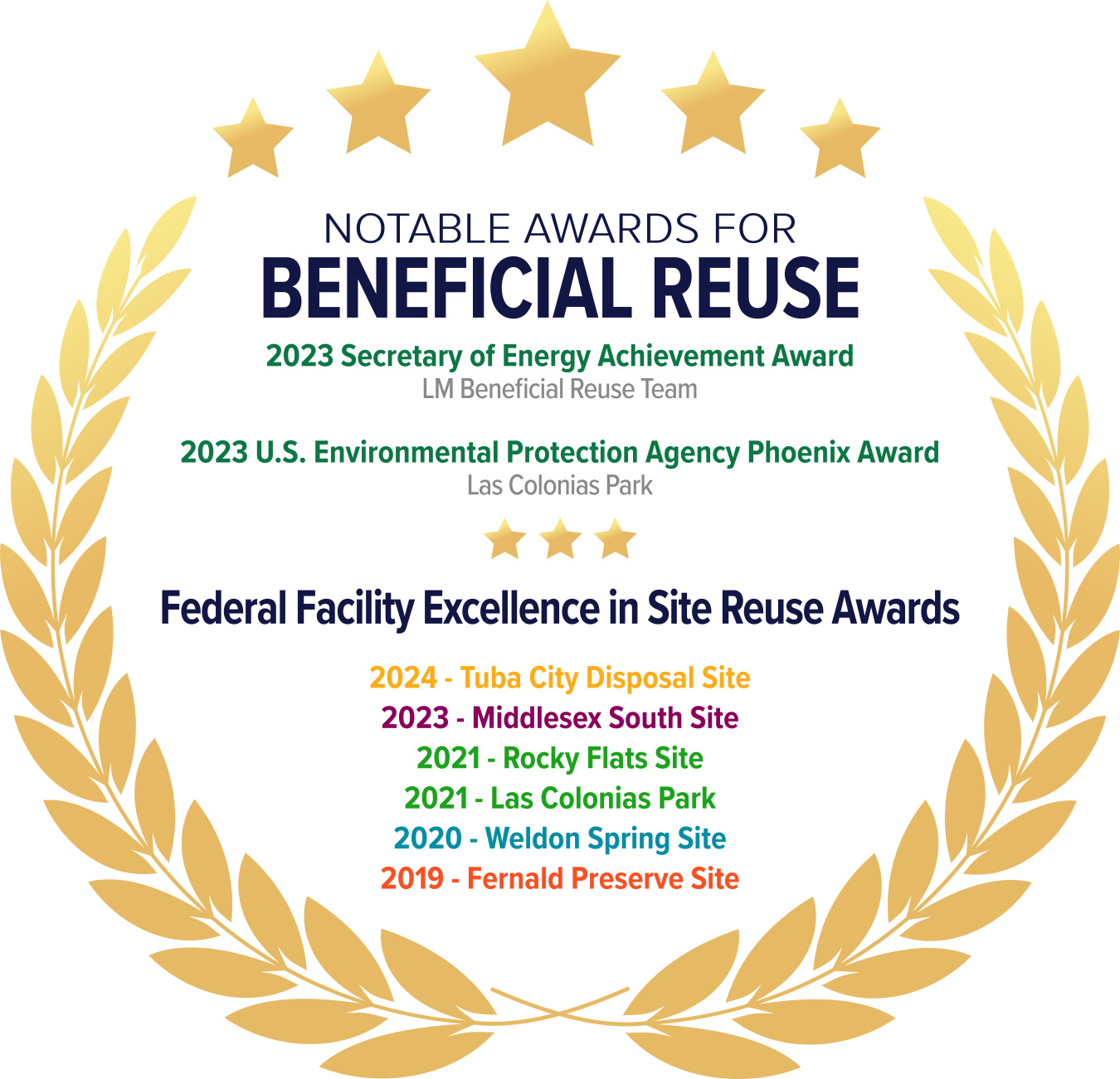As defined in LM’s Fiscal Year 2025–2035 Strategic Plan, LM established a goal to “sustainably manage and optimize the use of land and assets.” The intent is to place DOE legacy sites and property in the most beneficial use consistent with LM’s mission. LM considers environmentally sound land uses for properties in its custody. Where possible, LM makes lands and facilities available for government, public, and private use consistent with the tenets of sustainability and good land management practices.
In 2017, LM revised its Beneficial Reuse Program and developed a Beneficial Reuse Management Plan (BRMP) to promote potential reuse opportunities associated with LM’s diverse mix of sites and assets. The Beneficial Reuse Program supports and implements multiple-use scenarios in keeping with the vision of the surrounding communities and consistent with each site’s attributes. The BRMP outlines the types of reuse, goals and objectives of the program, criteria, metrics and planning of reuse activities.

LM’s beneficial reuse refers to the productive use of an LM-managed site (LM site), that no longer has a DOE mission after remediation, by LM or other entities, while being protective of human health and the environment. Reuse activities maintain protective use of lands and remedies, including revitalization of real property and disposal of land. Two main elements for reuse are:
- Protectiveness—activities are compatible with long-term maintenance and ensure protection of public health and the environment
- Environmentally sound—activities retain good stewardship of natural resources
LM’s goal to sustainably manage and optimize the use of land and assets, supports DOE’s overall asset reuse program. The intent is to place DOE legacy sites and property in the most beneficial use that is consistent with LM’s mission. DOE has a growing number of aging facilities and sites no longer required for mission activities. Those sites form the basis of LM’s real property asset portfolio. The objectives are to:
- Dispose of surplus property held by the federal government
- Maintain efficient use of government real property assets
- Reduce the total square footage of domestic office and warehouse inventory
In order to support LM’s long-term surveillance and maintenance (LTS&M) mission and long-term stewardship of DOE assets, LM’s real property asset inventory will grow as sites are transitioned. Thus, LM’s transition approach includes initial assessments of the most effective uses or reuses of these properties that support LTS&M activities, while still protecting human health and the environment. Once a site becomes part of LM’s inventory, LM continues to make assessments on a periodic basis, as LTS&M activities progress and closure plans and strategies are implemented.
LM supports the beneficial reuse of its sites through the following reuse opportunities:
Disposal is defined as the “permanent transfer of DOE control and custody of real property assets to a third party who thereby acquires rights to control, use, or relinquish the property” (DOE Order 430.1C). Disposal is LM’s preferred reuse option because it reduces DOE’s overall land holdings, the federal footprint, and associated costs. Either a portion of a site or an entire site can be disposed.

Wayne, New Jersey, Site.
Agricultural reuse includes using LM sites for activities such as livestock grazing, hay production, and livestock improvements.

Edgemont, South Dakota, Disposal Site.
Community reuse refers to the development of open space or recreational areas or using sites for educational purposes or community-driven activities. LM works with federal, state, and local community leaders; non-profit organizations; city planners; and other members of the public to identify appropriate land uses that will be compatible with current site conditions and with LM’s LTS&M obligations and responsibilities.
Groundbreaking for the new Weldon Spring Interpretive Center.
Redevelopment or adaptive reuses of LM sites means (1) repurposing LM facilities or land for industrial use, (2) redeveloping sites for commercial purposes such as warehouse or office space, and (3) supporting redevelopment of a parcel of land through an interagency agreement or partnership.

Middlesex South, New Jersey.
LM broadly defines energy-related reuse at LM sites as use of LM sites for energy-related activities such as solar photovoltaic (PV), wind, biomass, landfill gas, waste-to-energy, and geothermal technologies.

Solar panels at Tuba City, Arizona, Disposal Site.
Conservation reuse refers to the outcome of a remediation process and includes areas where a proactive measure has been implemented to create, restore, protect, or enhance a habitat.

Fernald Preserve, Ohio.
LM communicates the significant histories of its sites, the effectiveness of cleanup processes, and the residual risks to stakeholders in order to support LTS&M activities and any protective measures associated with the historic operations and closure of the site. Such methods of communication may include the engagement of stakeholders in the history of a site by means of signage, interpretive centers, listings on historic registers, and other informational devices.

Weldon Spring, Missouri, Site.
LM’s primary focus is on the LM sites that remain in federal ownership. However, LM may support partnership opportunities for beneficial reuse at non-LM-owned sites. Some LM sites are composed of multiple properties, thus the reuse program tracks individual properties at LM sites. As of December 2024, 100 percent of the 51 available LM sites are in reuse.
The Beneficial Reuse Team works closely with both internal and external organizations to develop beneficial reuse opportunities. Collaboration can involve a wide range of external and internal working relationships. Reuse activities can include supporting the LM site itself or adjacent land uses on properties that are owned or managed by multiple entities.
While the ultimate responsibility regarding beneficial reuse decisions on LM lands rests with LM, it is recognized that individuals, communities, and governments working together toward commonly understood objectives can significantly improve the stewardship of LM lands. Building collaborative partnerships can improve communication, create a better understanding of different perspectives, and provide better solutions for addressing issues.
Additional information on LM sites can be found at https://www.energy.gov/lm/sites/lm-sites
Land and Asset Transfer for Beneficial Reuse (June 2015)
Bud Sokolovich
Legacy Management Asset Management Supervisor
303-410-4810
Bud.Sokolovich@lm.doe.gov


